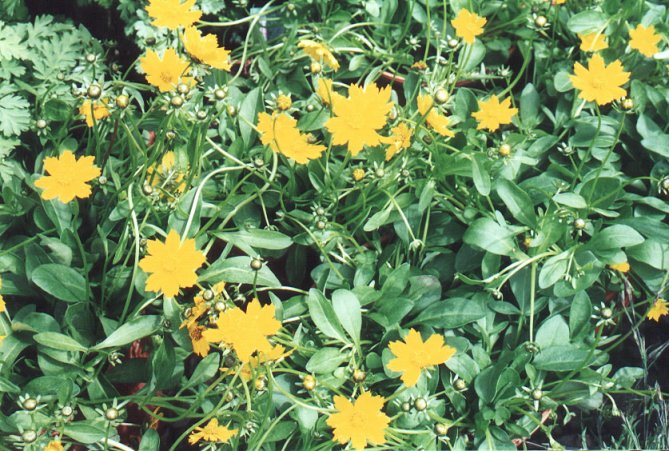| Botanical Name: Coreopsis auriculata 'Nana' | |
| Common Name: Nana Coreopsis |

-
Anatomy
-
Culture
-
Design
Plant Type
Ground cover, Perennial
Height Range
Under 1'
Flower Color
Yellow
Flower Season
Spring, Summer
Leaf Color
Green
Bark Color
n/a
Fruit Color
n/a
Fruit Season
n/a
Sun
Full, Half
Water
Medium
Growth Rate
Moderate, Slow
Soil Type
Sandy, Clay, Loam
Soil Condition
Average, Rich, Well-drained, Dry
Soil pH
Neutral, Basic
Adverse Factors
n/a
Design Styles
English Cottage, Meadow, Ranch, Seascape, Woodland
Accenting Features
Showy Flowers
Seasonal Interest
Summer
Location Uses
Entry, Perennial Border, Parking Strip, Patio, Raised Planter, Walkways
Special Uses
Container, Cut Flowers, Small Spaces
Attracts Wildlife
n/a
Information by: Stephanie Duer
Photographer:
Photographer:
-
Description
-
Notes
'Nana' is a spreading, dwarf coreopsis with mat-like foliage 6 to 9" tall consisting of dense, bushy, slowly-spreading clumps of broad-oval, shiny deep green leaves (to 1-3" long). Bright orange-yellow daisy-like flowers (1-2" diameter) with yellow rays (toothed at the tip) and yellow center disks appear singly on naked stems above the foliage in late spring to early summer. May sparsely rebloom throughout the summer into fall if spent flowers are regularly deadheaded. Good small area ground cover. Also effective as an edger for borders or walks and paths.
Grow in well-drained, slightly loamy soil in full to part sun. Plants tolerate some dry conditions, but are not as drought tolerant as most other species of Coreopsis. Prompt deadheading of spent flower stalks can be tedious for a large planting, but does tend to encourage additional bloom. In optimum growing conditions, plants will spread in the garden over time by stolons to form an attractive ground cover, but spread is easy to check.